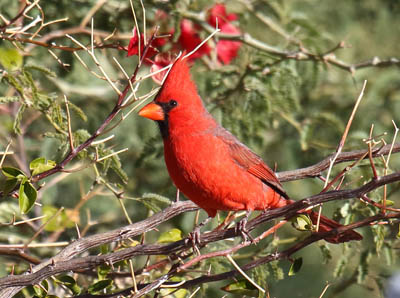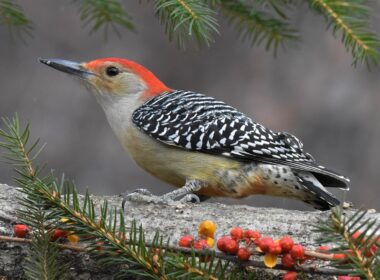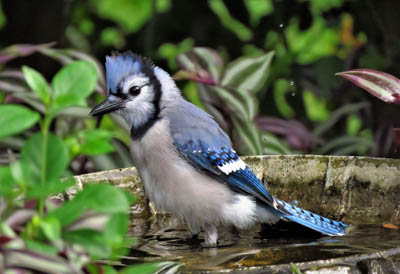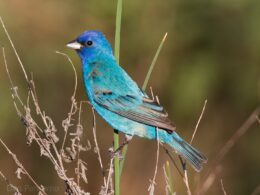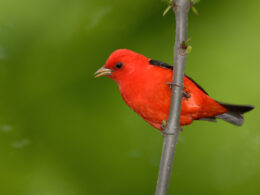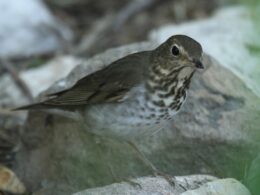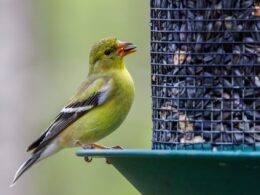Last Updated on January 17, 2024 by Greg Gillson
I’ve put this resource together for you to answer your question: What birds are in my backyard in Massachusetts?
This article lists and discusses the identification of the most common birds in your backyard. The birds chosen in this article are compiled from actual data from the citizen science program eBird. Thus, it is more accurate than some other similar articles you may find on the web. I provide pictures of each bird species mentioned and I’ll tell how to attract them to your backyard.
These are the most common backyard birds in Massachusetts:
- Black-capped Chickadee
- American Robin
- Blue Jay
- Northern Cardinal
- Song Sparrow
- American Crow
- Mourning Dove
- American Goldfinch
- Tufted Titmouse
- Downy Woodpecker
- House Sparrow
- Red-winged Blackbird
- White-breasted Nuthatch
- Common Grackle
- European Starling
- Gray Catbird
- Red-bellied Woodpecker
- House Finch
- Northern Flicker
- Dark-eyed Junco
- Carolina Wren
- White-throated Sparrow
- Chipping Sparrow
- Eastern Phoebe
- Northern Mockingbird
- Cedar Waxwing
- Barn Swallow
- Eastern Kingbird
- Baltimore Oriole
- Chimney Swift
Massachusetts Birds and Birding in Massachusetts State
eBird lists over 510 types of birds as occurring in the state of Massachusetts.
The most common bird in Massachusetts: the most frequently seen bird in the state is Black-capped Chickadee. It is reported on 49% of bird watching lists.
If you are serious about knowing the birds native to Massachusetts, then check out eBird for Massachusetts. It has recent sightings and photos, illustrated checklists with weekly abundance bar charts for state, counties, and individual hotspots of the best birding locations. If you want to know about other people interested in birds in your area, join a local bird group. The American Birding Association maintains a list of bird watching clubs for each state.
Massachusetts Bird Identification
This section is the species accounts. These are designed to help you to recognize birds you see in your backyard. I have used eBird to select the birds that are most common. “Common” means the birds seen most often throughout the year, not necessarily the most numerous.
Each species account starts with a photograph. In the identification section I am using size and shape and bill type before considering the color or patterns on the birds. I find these more reliable when trying to identify an unknown bird. Pay attention to body and tail shape and especially bill shape of birds you see, not just plumage color.
In the section on bird feeders and foods I tell how to attract each species. Not all types of backyard birds will come to feeders. But all backyard birds can be attracted with water. So don’t forget to add a birdbath to your bird feeding station.
Where do you live in this New England state? Western Massachusetts or Cape Cod? Central Massachusetts? The Berkshires? Southeastern Massachusetts?
To appear in this article, most birds are widely distributed throughout the state and are often year-round residents. However, for those birds that are more localized in place or time, I list the general region and seasonality. Please see the section following these species accounts for the lists of common species by season.
Even if a species is found in a general area, they occur only in the habitat they prefer. So, the exact habitat of your neighborhood is important for the presence of absence of certain kinds of birds.
1. Black-capped Chickadee (Poecile atricapillus)
This is a common backyard bird in the northern half of the United States.
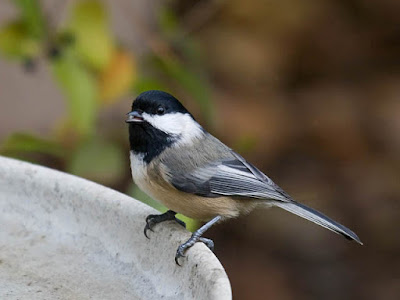 |
| Black-capped Chickadee. Greg Gillson |
Range in Massachusetts: Back-capped Chickadees are year-round residents throughout Massachusetts.
Identification:
Size: Chickadees are small birds, the same general size as an American Goldfinch.
Shape: Round body, big round head, long tail with rounded tip.
Bill: Short, straight, stout.
Color: Gray above, buffy below. Black cap and bib with white lower face. White edges on wing feathers.
Habitat, range & behavior: Deciduous and mixed forests.
They range from the northern half of the United States, southern half of Canada, and most of Alaska.
Small flocks flit actively from tree to tree acrobatically gleaning insects from twig tips. In winter chickadees make up the core of mixed-species flocks also containing nuthatches, kinglets, creepers, woodpeckers and others.
Food and feeder preference: Seeds, insects, berries. They eat at tube, hopper and tray feeders. Attract with black oil sunflower seeds and suet.
You may like my in-depth article on attracting Black-capped Chickadees.
2. American Robin (Turdus migratorius)
This familiar backyard bird is a resident in the northern half of the United States and a common winter visitor in the southern half.
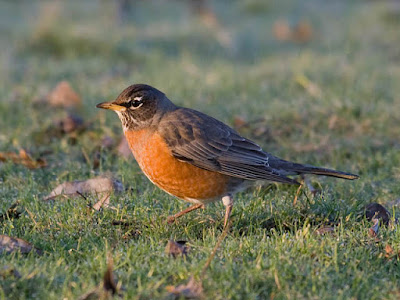 |
| American Robin. Greg Gillson |
Range in Massachusetts: American Robins are year-round residents throughout Massachusetts.
Identification: This is a key species for comparing with an unknown bird.
Size: 10 inches long from bill tip to tail tip. About the same size as a Blue Jay or one of the Scrub-Jays. Larger than Red-winged Blackbird. Smaller than a Mourning Dove.
Shape: Very plump with a fairly long tail.
Bill: Straight and fairly slender, curved at the tip.
Color: Gray-brown upperparts, rusty orange breast.
Habitat, range & behavior: Open woodlands, farmlands, urban parks and lawns.
Migratory, breeds north across Alaska and Canada. Resident in most of the United States (lower 48). Winters in the United States, Mexico, to central America.
Hops on your lawn turning head this way and that looking for food. Their caroling song is one of the early signs of spring in the north.
Food and feeder preference: Worms and other invertebrates in the lawn. May eat fruit from a tray feeder or the ground. Eat small berries from trees and bushes.
3. Blue Jay (Cyanocitta cristata)
A common and well-known bird in the eastern half of the United States.
 |
| Blue Jay. skeeze from Pixabay |
Range in Massachusetts: Blue Jays are year-round residents throughout Massachusetts.
Identification:
Size: About that of American Robin.
Shape: Fluffy, large crested head, ample tail. Large strong legs.
Bill: Black, long and stout.
Color: Blue above, white below. Black neck collar. White patches in wing.
Habitat, range & behavior: Woodlands and towns.
Found in the eastern half of the United States. In summer into southern Canada.
Bold and brash. May bully smaller birds. Jays gulp lots of seeds or other food at once, storing it in their crop. Then they fly off and bury food items in a hidden cache.
Food and feeder preference: Omnivorous. They can quickly empty your feeder! Because they are also aggressive toward other feeder birds, some people put mesh cages around smaller bird feeders. Small birds can go through, squirrels and larger “pest” birds are prevented entry. Some people feed jays peanuts, perhaps away from the seed feeders.
4. Northern Cardinal (Cardinalis cardinalis)
This is one of the most common and popular backyard birds in the eastern half of the United States.
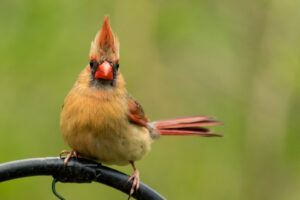
Range in Massachusetts: Northern Cardinals are year-round residents throughout Massachusetts.
Identification:
Size: Cardinals are a bit smaller than American Robins, about the same size as Red-winged Blackbirds.
Shape: Plump body with fairly long full tail. Wispy crest.
Bill: Short, heavy, conical, pink.
Color: That bright red color is matched by few other birds. Black face. The female is more gray, but with hints of red in wings and tail, and has a crest, too.
Habitat, range & behavior: Cardinals are year-round residents in shrubby woodland edges.
Found from the eastern United States to Texas and Arizona south into Mexico.
That large conical bill is made for chewing seeds. Watch them crack open sunflower seeds, spit out the hulls, and pluck the kernel with their tongues!
Food and feeder preference: Attract with safflower and black oil sunflower seeds. Many types of seeds, berries, nuts in larger hopper or tray feeders.
You may like my in-depth article on attracting Northern Cardinals.
5. Song Sparrow (Melospiza melodia)
A common bird, but variable, and similar to many other streaked brown sparrows.
 |
| Song Sparrow. Greg Gillson |
Range in Massachusetts: Song Sparrows are year-round residents throughout Massachusetts.
Identification:
Size: A smaller bird, similar in size to House Finch and juncos. Larger than chickadees and goldfinches. Smaller than White-crowned Sparrows or Spotted/Eastern towhees.
Shape: Plump with round head, long rounded tail.
Bill: Short, conical.
Color: Highly variable in darkness and color saturation across its range (dark rusty to pale gray). Generally gray-brown above with dark brown streaking on back. Complicated head pattern. Streaking on sides and breast converge into dense central breast spot.
Habitat, range & behavior: Thickets, especially near water. Backyard shrubbery.
Resident in western United States, western Canada, coastal southern Alaska, northeastern US. In summer also moves into mid-Canada and northern half of US. In the winter found in most of the US lower-48. Also a population in central Mexico.
Forages on ground, never far from low cover to which they fly if startled.
Food and feeder preference: They feed on seeds and insects near the ground. Will visit hopper and tray feeders for mixed bird seed.
6. American Crow (Corvus brachyrhynchos)
This larger all-black bird is common in cities and country. Its cawing call is familiar to most people.
 |
| American Crow. Greg Gillson |
Range in Massachusetts: American Crows are year-round residents throughout Massachusetts.
Identification: This is a key species for comparing with an unknown bird.
Size: About 17-1/2 inches long from bill tip to tail tip, though there is much size variation throughout its range. Larger than blackbirds and grackles. Smaller than ravens.
Shape: Thick neck, large head, rather short square-ended tail. Longer legs. In flight has rounded wing tips with each primary feather separated from others forming “fingers.”
Bill: As long as head, thick, black.
Color: Glossy black throughout.
Habitat, range & behavior: They prefer open areas with trees, fields, farms, cities.
They are common across most of the United States lower-48, except in the desert southwest. They move into southern Canada in summer.
They gather in evening communal roosts in large flocks that may number into the thousands and then move out at dawn into the surrounding area.
Food and feeder preference: Omnivorous, they feed on large insects, grain, small mammals, carrion. You probably don’t want these large entirely black birds in your backyard feeders. So don’t feed table scraps to birds.
7. Mourning Dove (Zenaida macroura)
Mourning Doves are the most widespread and most frequent backyard bird in the Lower 48 states of the United States.
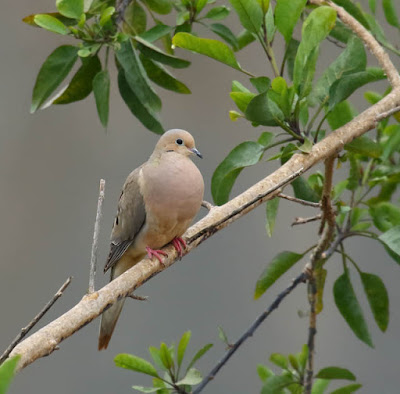 |
| Mourning Dove. Greg Gillson |
Range in Massachusetts: Mourning Doves are year-round residents throughout Massachusetts.
Identification: This is a key species for comparing with an unknown bird.
Size: About 12 inches long from bill tip to tail tip. About same size as Northern Flicker. Larger than American Robin. Slightly smaller than domestic city pigeon.
Shape: Very plump with a small round head. Tail is long and pointed. Legs are short.
Bill: Small and rather slender.
Color: Pale brown-pink body, darker wings and tail. White edges on side of tail.
Habitat, range & behavior: Semi-open areas such as urban areas, farmlands, woods. Often seen perched on wires, fences.
It is a resident across the lower-48 states and Mexico, with some movement out of northern areas in winter.
Their mournful cooing is a familiar spring birdsong.
Food and feeder preference: Mourning Doves eat seeds almost exclusively. Attract with black oil sunflower seeds on a large sturdy tray feeder or on the ground.
8. American Goldfinch (Spinus tristis)
A beautiful tiny backyard finch familiar to many in its bright yellow summer plumage. Colloquially called a “wild canary.”
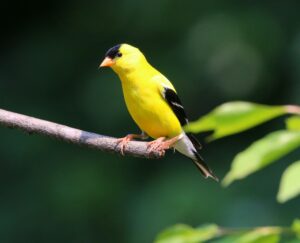
Range in Massachusetts: American Goldfinches are year-round residents throughout Massachusetts.
Identification: This is a key species for comparing with an unknown bird.
Size: Very small at about 5 inches from bill tip to tail tip. Similar in size to a chickadee. Larger than hummingbirds. Smaller than juncos and House Finches.
Shape: Tiny, somewhat plump with larger head and short tail.
Bill: Short, conical, pink.
Color: Males in summer are bright lemon yellow with black forehead and black wings and tail with white bars. White under tail coverts. Females are dull olive, wings and tail browner. Winter birds are pale grayish-yellow with tan and brown wings and tail.
Habitat, range & behavior: This species is found in weedy fields and similar clearings with thistles and similar plants.
It is found coast-to-coast throughout the year across most of the middle lower-48 states. In summer moves north to the Canada border. In the winter found south to the Mexico border.
The flight is highly undulating, rising and falling as they flap in short bursts. Besides a long, sweet lilting song, they call in flight a lilting 4-part: “potato chip!”
Food and feeder preference: Feeds on weed seeds, thistle seed. May eat black oil sunflower seeds from tube feeder. Attract with Niger seed in a feeder called a “thistle sock.”
You may like my in-depth article on attracting American Goldfinches.
9. Tufted Titmouse (Baeolophus bicolor)
Related to chickadees, These common backyard birds lack the black bib, but have a crest instead.
 |
| Tufted Titmouse. anne773 from Pixabay |
Range in Massachusetts: Tufted Titmice are year-round residents throughout Massachusetts.
Identification:
Size: A small bird, but a large titmouse, this species is larger than chickadees, about the size of a junco or House Finch.
Shape: Rounded body, long full tail, big head, long legs.
Bill: Short and stout, compressed (taller than wide), black.
Color: Dark blue-gray above, pale below. Black feathers around eye accentuates its size.
Habitat, range & behavior: Lives in deciduous forests with heavy canopy, parks.
Found in eastern and southeastern United States is expanding its range north and west.
Backyard bird feeders might be helping this species expand its range northward.
Food and feeder preference: Insects and seeds. At your hopper or tray feeder attract with black oil sunflower seeds and suet.
10. Downy Woodpecker (Dryobates pubescens)
This tiny woodpecker is found in backyards across the United States.
 |
| Downy Woodpecker. Greg Gillson |
Range in Massachusetts: Downy Woodpeckers are year-round residents throughout Massachusetts.
Identification:
Size: Bigger than a junco or House Finch. Smaller than a Red-winged Blackbird. About the same size as a White-crowned Sparrow, but with a much shorter tail.
Shape: Stocky with large head and short stiff tail.
Bill: Short, chisel-shaped.
Color: Black-and-white striped head. Black wings with white spots. Solid white back. White under parts. Black tail with white outer tail feathers with black bars or spots. Male with small red spot at back of head.
Habitat, range & behavior: Found in small deciduous trees, willows, and even weed stocks such as teasel, especially near water.
Ranges coast-to-coast across all but northernmost parts of Canada and Alaska south to the southern US. Absent in the desert southwest.
Interestingly, I learned today that the males may more often be found in smaller plants and twigs, while females are more likely on tree trunks.
Food and feeder preference: Insects, fruits, and seeds. Gleans arthropods from the bark of trees. Attract with suet feeder. Will also eat black oil sunflower seeds.
11. House Sparrow (Passer domesticus)
Like the starling, this is another bird introduced from Europe in the 1800’s. This sparrow is commonly found in cities and farmlands. It is considered a pest in most areas where it has been introduced.
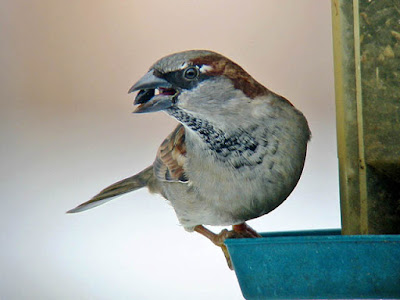 |
| House Sparrow. Greg Gillson |
Range in Massachusetts: House Sparrows are year-round residents throughout Massachusetts.
Identification:
Size: The size of a House Finch or Dark-eyed Junco.
Shape: Chunkier than native North American sparrows with large head, barrel chest, short neck, medium tail, short legs.
Bill: Short, conical.
Color: Males are brown and gray with a black mask. Females lack the black and are tan and brown with a pale line back from the eye.
Habitat, range & behavior: Cities and farms.
Range in North American from southern Canada through Central America. In summer northward through Canada to southern Alaska. Originated in Middle East and spread to most of Europe and Asia. Introduced in South America, Africa, Australia–nearly anywhere there are people and cities.
They tend to be messy… and have a good appetite and may occur in large noisy chirping flocks. They are aggressive toward other feeder birds.
Food and feeder preference: They eat grain, seed, and insects. To discourage them from your hopper and tray feeders do not feed birds human food scraps. They have a bit of difficulty eating from tube feeders.
12. Red-winged Blackbird (Agelaius phoeniceus)
These noisy flocking birds are most often found in marshes. But in winter they are found in backyards.
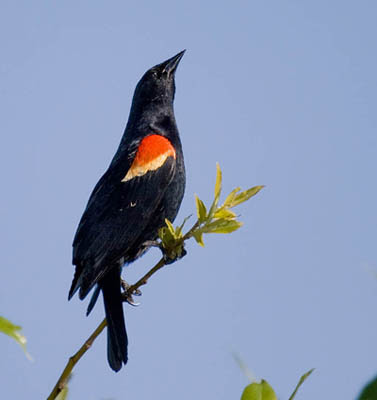 |
| Male Red-winged Blackbird. Greg Gillson. |
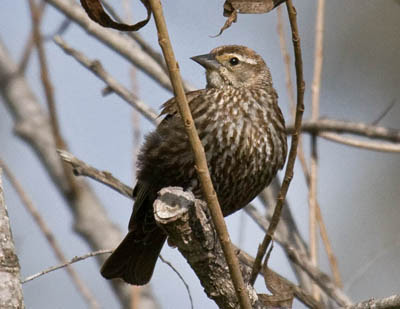 |
| Female Red-winged Blackbird. Greg Gillson. |
Range in Massachusetts: Red-winged Blackbirds are year-round residents throughout Massachusetts.
Identification: This is a key species for comparing with an unknown bird.
Size: About 8-3/4 inches long from bill tip to tail tip. About the size of a Northern Cardinal. Smaller than an American Robin.
Shape: Pot-bellied with a longer bill and flat forehead. Tail average.
Bill: Long and sharp pointed.
Color: Males are black with red and yellow shoulder patch. Females are streaked brown and rusty (sparrow-like but pointed bill and flat forehead).
Habitat, range, and behavior: Cattail marshes and wetlands are their summer habitat. In winter they feed in grain fields.
They breed across most of the North American continent. In winter they withdraw from most of Alaska and Canada.
They are found in colonies in summer and large flocks in winter.
Food and feeder preference: They eat insects in summer. In winter they eat grain and seeds. They visit feeders, more often in large winter flocks, and eat most seeds and suet.
13. White-breasted Nuthatch (Sitta carolinensis)
A favorite backyard feeder bird for many for its active antics and fearlessness. Though a small bird it is the largest nuthatch in North America.
 |
| White-breasted Nuthatch. Greg Gillson |
Range in Massachusetts: White-breasted Nuthatches are year-round residents throughout Massachusetts.
Identification:
Size: About chickadee-sized in length. Smaller than a junco or House Finch.
Shape: Appears large-headed, neckless, very short tailed. Short legs.
Bill: Nearly as long as head, straight, thin.
Color: Blue-gray above, white below. Black cap, wing tips, tail. Rusty feathers under tail.
Habitat, range & behavior: Common in oak and oak-pine woodlands, wooded towns.
Found across the United States, southern Canada, mountains of central Mexico. Absent from treeless grasslands, deserts in the west.
Crawls over tree branches and head-first down tree trunks searching for insects.
Food and feeder preference: Insects, seeds, acorns and other nuts. Attract with black oil sunflower seeds feeding on hopper and tray feeders. Suet blocks.
14. Common Grackle (Quiscalus quiscula)
Sometimes considered a pest to crops, grackles are longer and lankier than very similar blackbirds.

Range in Massachusetts: Common Grackles are year-round residents throughout Massachusetts.
Identification:
Size: Larger than Red-winged Blackbirds, they are near the length of Mourning Doves.
Shape: Long, with long full keel-shaped tail, long legs, flat crown.
Bill: Longer than head, pointed, but stouter than other blackbirds.
Color: Glossy black with hint of bronze or green on head (depending upon population). Yellow eye.
Habitat, range & behavior: They are found in agricultural areas, woodland edges, city parks and lawns.
Resident in the southeastern United States. In summer they migrate northward and west to the central United States and Canada.
They monopolize feeders and are bullies toward other birds.
Food and feeder preference: Grain, corn, acorns, small aquatic fish and amphibians. To discourage them, use tube feeders, rather than hopper or tray feeders. Don’t over-feed, keep spilled seed picked up.
15. European Starling (Sturnus vulgaris)
Introduced to North America in the late 1800’s, they crossed the continent, often to the detriment of native cavity-nesting birds. The prime example of an invasive species.
 |
| European Starling. Greg Gillson |
Range in Massachusetts: European Starlings are year-round residents throughout Massachusetts.
Identification: This is a key species for comparing with an unknown bird.
Size: 8-1/2 inches from bill tip to tail tip. About the size of a Red-winged Blackbird. Smaller than an American Robin. Larger than a White-crowned Sparrow or Spotted/Eastern towhee.
Shape: Stocky with large head, short square-ended tail. Longer legs.
Bill: As long as head. Sharp pointed. Yellow in spring, otherwise dark.
Color: They are grayish brown much of the year, with glossy iridescence and white spotting during the spring.
Habitat, range & behavior: Lowland birds that need trees large enough for nest cavities but plenty of open area for feeding. They are most abundant in urban and suburban areas where they find food and artificial nest cavities.
Resident from coast-to-coast from southern Canada to northern Mexico. In summer north across Canada and Alaska. Native range is Europe to Pakistan, north Africa.
Often viewed as a pest, starlings often bully other backyard birds, taking over bird feeders, and stealing nest cavities from smaller native birds. In winter they can form into flocks of tens of thousands.
Food and feeder preference: Primarily insects when available, often feeding on the ground. Discourage them from your backyard hopper and tray feeders by never feeding birds table scraps (including bread or meat). They have weak feet and do not perch well on tube feeders. A cage mesh around smaller hopper feeders may keep them out.
16. Gray Catbird (Dumetella carolinensis)
This bird is rather common where it occurs, but a bit secretive.
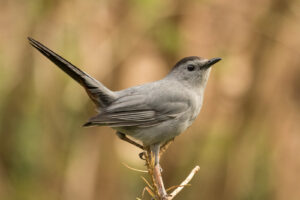
Range in Massachusetts: Gray Catbirds are summer residents throughout most of Massachusetts, year-round residents in the southeastern part of the state.
Identification:
Size: About the length of a Red-winged Blackbird or Northern Cardinal.
Shape: Long tailed, round head.
Bill: Medium length, pointed.
Color: Gray with a black tail and black cap. Rusty under tail coverts.
Habitat, range & behavior: Dense woodland edges, scrub, abandoned orchards.
Breeds in eastern and central US and adjoining southern Canada. Winters in extreme south US Gulf states, southward in eastern Mexico to Panama.
They spend much time hopping on the ground or in low bushes. They defend a winter territory, unlike most birds.
Food and feeder preference: Insects and berries. You may attract this species with jelly and fruit feeders, suet, and water.
17. Red-bellied Woodpecker (Melanerpes carolinus)
This is one of the most common backyard species in the eastern half of the United States.
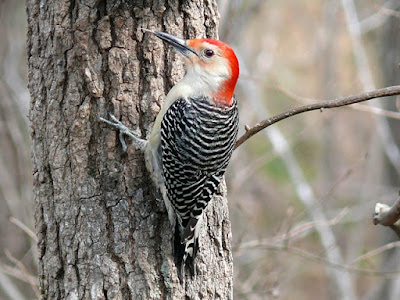 |
| Red-bellied Woodpecker. skeeze from Pixabay |
Range in Massachusetts: Red-bellied Woodpeckers are year-round residents throughout Massachusetts.
Identification:
Size: Fairly large for a backyard bird. Between a Starling and American Robin in size. Smaller than a Northern Flicker.
Shape: Stout with large head and short tail. Clings to tree trunk on strong short legs propped up with short stiff tail.
Bill: Long, chisel shaped.
Color: Pale gray body, many thin black-and-white bars across back and wings. Red nape, extending forward on crown on male.
Habitat, range & behavior: These birds are found in many woodland types, including oak, hickory and pine.
They are found from the eastern slope of the Rocky Mountains in the lower-48 states from Texas to extreme southern Canada, and eastward from Florida northward just to the southern edge of the New England states.
In typical woodpecker fashion, it hitches up the tree trunk and larger branches.
Food and feeder preference: This species eats insects and nuts. They may eat peanuts from a tray feeder and eat from a suet block.
18. House Finch (Haemorhous mexicanus)
These are one of the most common backyard birds in the United States. There are other red finches, but these are the ones most likely in residential areas.
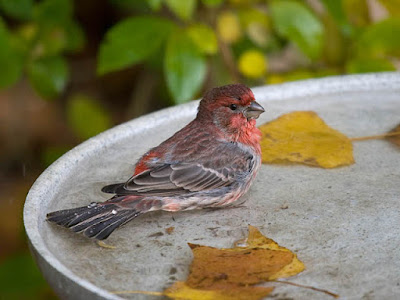 |
| House Finch. Greg Gillson. |
Range in Massachusetts: House Finches are year-round residents throughout Massachusetts.
Identification: This is a key species for comparing with an unknown bird.
Size: About 6 inches from bill tip to tail tip. Larger than goldfinches and chickadees. Smaller than a White-crowned Sparrows or Spotted/Eastern towhees.
Shape: Medium build with a medium-long notched tail. Round head.
Bill: Short, conical.
Color: Brown and gray above with streaks on the sides of the pale underparts. Males with red (sometimes orange or rarely yellow) crown, chest, rump.
Habitat, range & behavior: You’ll find small flocks on wires, in short treetops and in bushes. Originally deserts and grasslands. Rural areas and towns are where they’re now most common.
Formerly found in the western United States and Mexico. Then introduced into the northeastern United States, but now found in nearly all of the lower-48 states and extreme southern Canada. Rare in plains states (Dakotas to Texas) and southern Florida.
House Finches are not territorial, but males sing throughout the year–a lively, wiry song ending in a couple of buzzy notes.
Food and feeder preference: Attract House Finches with sunflower seeds and tube feeders. May eat from thistle socks.
You may like my in-depth article on attracting House Finches.
19. Northern Flicker (Colaptes auratus)
Of all the bird identification questions I get asked, this common larger backyard bird is the bird most people ask about. It doesn’t occur to those unfamiliar with it that this could be a woodpecker.
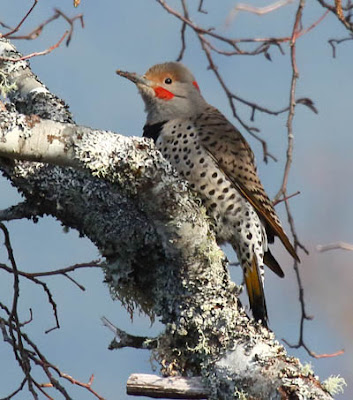 |
| Northern Flicker. Greg Gillson. |
Range in Massachusetts: Northern Flickers are year-round residents throughout Massachusetts.
Identification:
Size: About the size of a Mourning Dove. Larger than a robin.
Shape: Stocky with short legs, short tail, big head.
Bill: As long as head, thin, slightly curved.
Color: Back is brown with black bars. Under parts pinkish with black spots. Undersides of black wing and tail feathers are bright salmon red (West) or yellow (East). Head gray (West) or brown (East) and males with red (West) or black (East) whisker marks and nape marks (East). Black crescent across chest. White rump seen in flight.
Habitat, range & behavior: Found in woodland edges and forests.
Year-round resident from extreme southern Canada, across all of the lower-48 states and in the mountains of Mexico and Middle America. In summer breeds northward well into Canada and Alaska.
Frequently noted hopping on ground pecking in the ground for insects. In late spring, males proclaim their territory by rapid pounding on a hollow tree branch, though the ringing of metal downspouts at dawn is louder and carries much farther, to the exasperation of anyone trying to sleep inside!
Food and feeder preference: Ants and beetles are their primary foods. Will eat black oil sunflower seeds and are attracted to suet.
20. Dark-eyed Junco (Junco hyemalis)
Colloquially called “snowbirds,” they often arrive in backyards in winter from nearby mountain forests or more northern climes.
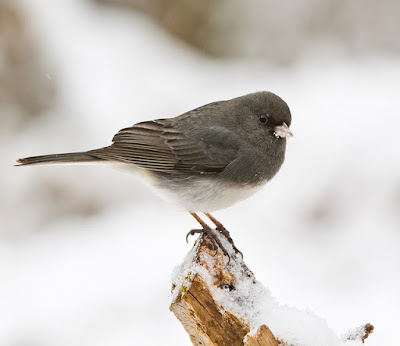 |
| Dark-eyed Junco. skeeze from Pixabay |
Range in Massachusetts: Dark-eyed Juncos are year-round residents through the interior of Massachusetts, winter visitors only in the eastern part of the state.
Identification:
Size: Small birds about the size of a House Finch.
Shape: Round body, short neck, round head, fairly long square-ended tail.
Bill: Short, pointed, conical, pink.
Color: Eastern birds are a darker all-gray with white belly. Western birds have jet black hood over their head, brown back, and pink sides.
Habitat, range & behavior: Breed in coniferous forests. Winters widely. Avoids heavy brush, preferring widely spaced bushes.
Breeds across most of Canada, Alaska, and the western half of the United States. Winters from southern Canada and all of the lower 48-states to extreme northern Mexico.
Spend much of their time hopping and feeding on the ground.
Food and feeder preference: Eats mostly seeds, also insects in summer. Readily feed at backyard feeders on mixed seeds on hopper or tray feeders and ground.
You may like my in-depth article on attracting Dark-eyed Juncos.
21. Carolina Wren (Thryothorus ludovicianus)
This is a fairly common backyard bird in the much of the eastern United States.
 |
| Carolina Wren. theSOARnet from Pixabay |
Range in Massachusetts: Carolina Wrens are year-round residents throughout Massachusetts.
Identification:
Size: A smaller bird, between the size of American Goldfinch and House Finch.
Shape: Round body, short neck, flat head, long tail flipped about actively.
Bill: Fairly long, thin, pointed and slightly curved.
Color: Upper parts rusty brown with black bars on the wings and tail. A white eyebrow line and buff under parts.
Habitat, range & behavior: Shrubby thickets and brushy suburban yards.
It is found in the southeastern United States and Yucatan. Northern parts of range expand and contract depending upon harshness of winters.
Males sing throughout the year and are very loud for their size.
Food and feeder preference: Feed mostly on insects and spiders. They will feed on suet.
22. White-throated Sparrow (Zonotrichia albicollis)
A fairly common bird of northern forests that visits backyards across much of the US.
 |
| White-throated Sparrow. Greg Gillson |
Range in Massachusetts: White-throated Sparrows are year-round residents in interior Massachusetts, winter visitors only in the eastern part of the state.
Identification:
Size: Similar in size to White-crowned Sparrow. Bigger than a House Finch; smaller than a starling.
Shape: Longer body. Round head on short neck. Long tail with notched tip.
Bill: Short. conical.
Color: Striped tan and brown above, pale gray below. White-striped form with black and white head stripes. Tan-striped form with tan and brown striped head. First year birds are similar to tan-stiped adults, but streakier overall. Yellow spot between eyebrow and bill. White throat strongly offset from gray breast and face.
Habitat, range & behavior: Found in forests, brush, and open woodland edges.
Breeds across Canada and northernmost Eastern United States. Winters in the eastern US, southern central US, and rare but regular along the West Coast.
Found in small flocks on ground near brush into which they can flee. Kick up leaves to search under for food.
Food and feeder preference: Eat seeds and berries in winter, more insects and fruit in summer. In your feeder will eat mixed seeds on a platform feeder and on the ground.
23. Chipping Sparrow (Spizella passerina)
Chipping Sparrows are a widespread species adapted to human disturbance. They are rather tame. They are frequently found in cemeteries with large trees.
 |
| Chipping Sparrow. Greg Gillson. |
Range in Massachusetts: Chipping Sparrows are summer residents throughout Massachusetts.
Identification:
Size: These are small sparrows, bigger than goldfinches or chickadees, but smaller than House Finches or Song Sparrows.
Shape: Plump and fairly long tailed.
Bill: Short and conical.
Color: Striped brown and dark brown above. Grayish under parts. Black line through eye. Crown streaked in winter but in summer becomes solid chestnut. Two white wing bars.
Habitat, range & behavior: Grassy open conifer woodlands with some shrubs, parks, orchards.
Breeds from Alaska, across Canada and south into highlands of Middle America. In winter retreats from northern areas to southern United States and northern Mexico.
In summer solitary or in pairs. In winter they forage in flocks of up to 50 birds.
Food and feeder preference: Weed seeds, supplemented with insects in summer. They may eat black oil sunflower seeds in your feeder, but more likely will feed on mixed seeds on the ground under the feeder.
24. Eastern Phoebe (Sayornis phoebe)
This plain bird is common in backyards in the East.
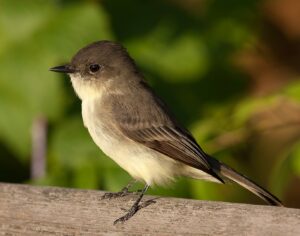
Range in Massachusetts: Eastern Phoebes are summer residents throughout Massachusetts.
Identification:
Size: About the size of bluebirds. Larger than House Sparrows.
Shape: Rather stout, with long wings, medium-length tail. Pointed but flat bill. Upright posture.
Bill: Black, pointed, wide and flat.
Color: Brownish gray above, slightly yellow-olive on sides. White under tail coverts. No eye ring or wing bars help distinguish them from some other flycatchers.
Habitat, range & behavior: Found in woodlands, suburbs, farms. Frequently nest in rafters, under eaves, porches.
They are summer residents east of the Rocky Mountains from Canada southward. Year-round residents through the interior of the Southeast, to Texas. Winter visitor to Gulf Coast and southern Atlantic.
Phoebes pump their tail down. They also frequently spread their tails.
Food and feeder preference: They eat flying insects that they catch on the wing. Not a feeder visitor.
25. Northern Mockingbird (Mimus polyglottos)
This common bird sings from exposed perches most of the year and often through the night. They have an unending supply of their own unique short phrases that they repeat about 3 times each, but frequently intersperse songs of other birds.
 |
| Northern Mockingbird. Greg Gillson. |
Range in Massachusetts: Northern Mockingbirds are year-round residents throughout Massachusetts.
Identification:
Size: The length of an American Robin.
Shape: Slender and long tailed. Long legs.
Bill: Medium length, slender, slightly curved.
Color: Gray, darker above, with white patches in wing and tail.
Habitat, range & behavior: They prefer edge habitat with scattered trees and bushes, parks and residential areas.
They are found in eastern and southern parts of the US, West Indies, and south into Mexico.
They boldly defend their nests from other birds, cats, and intruders.
Food and feeder preference: Northern Mockingbirds eat insects, berries, and fruit. You may attract mockingbirds to your feeder with grapes, raisins, apple slices. They will come to a suet block. They readily use a bird bath.
26. Cedar Waxwing (Bombycilla cedrorum)
Waxy red tips to the wing feathers of these backyard birds give them their unique name. Maybe it’s the fancy crest. Maybe it’s the bandit mask. Maybe it’s the yellow band at the tip of its tail. But these are one of my favorite birds.
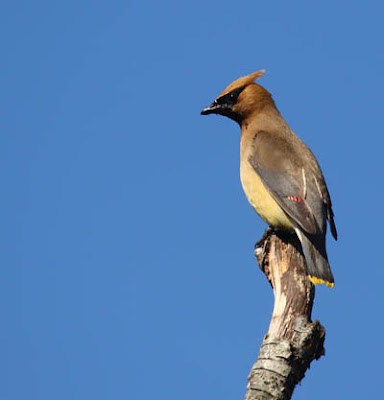 |
| Cedar Waxwing. Greg Gillson. |
Range in Massachusetts: Cedar Waxwings are year-round residents throughout Massachusetts.
Identification:
Size: Smaller than European Starling. Larger than House Sparrow.
Shape: Similar to European Starling. Rather stocky. Short squared tail, but long under tail coverts. Large head. Pointed wings. Wispy crest.
Bill: Rather short, small, wide.
Color: Warm brown above with wispy crest. Black mask. Yellowish belly. White under tail coverts. Gray wings. Gray tail with yellow tip.
Habitat, range, & behavior: Deciduous woods, wooded streams and lakeshores, residential shade trees, fruit orchards.
Resident across the northern US. Summer resident in Canada. Winter visitor throughout all of US and Mexico.
Keep in tight flocks. Feed in trees and large bushes for berries. Fly catch over ponds and streams.
Food and feeder preference: Berries and flying insects. Usually don’t come to feeders unless fruit like cherries offered but will visit bird baths.
27. Barn Swallow (Hirundo rustica)
These common swallows are widely distributed throughout the world, primarily breeding in the northern hemisphere, and wintering in the mid-latitudes and southern hemisphere.
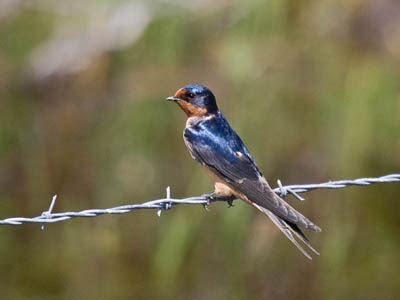 |
| Barn Swallow. Greg Gillson. |
Range in Massachusetts: Barn Swallows are summer residents throughout Massachusetts.
Identification:
Size: About the size of a House Finch but with a much longer tail.
Shape: Stocky, short necked but with long body and tail. Tail is forked, with very long outer tail feathers. Wings pointed.
Bill: Short, wide.
Color: Glossy dark purplish-blue above. Pinkish-orange below.
Habitat, range & behavior: Barn Swallows live in open country, frequently near humans. Farmlands. Nest in barns, under small bridges.
In North America breed from Mexico to northern Canada and Alaska, wintering from southern Mexico throughout most of South America.
Frequently seen swooping low over the ground hunting flying insects. Perch on wires, fences. Voice is twitters and chirps with grating sounds.
Food and feeder preference: Eat flying insects on the wing and are not attracted to backyard feeders.
28. Eastern Kingbird (Tyrannus tyrannus)
These birds often build nests in trees that overhang streams.
 |
| Eastern Kingbird. Greg Gillson. |
Range in Massachusetts: Eastern Kingbirds are summer residents throughout Massachusetts.
Size: About the size of a Red-winged Blackbird. Smaller than a robin.
Shape: Fairly sleek. Perches upright with big puffy head, full tail.
Bill: Fairly long, wide at base,
Color: Black head. Black tail with white band at tip. Dark gray upper parts. White under parts.
Habitat, range & behavior: Farms, clearings in woodlands.
Found across Canada and in the United States east from the Rocky Mountains.
These birds perch on fence lines, tips of small trees. Sally out and snatch flying insects and return to perch.
Food and feeder preference: They eat insects and do not come to feeders.
29. Baltimore Oriole (Icterus galbula)
These are beautiful summer songbirds in the East.
 |
| Baltimore Oriole. Michael McGough from Pixabay. |
Range in Massachusetts: Baltimore Orioles are summer residents throughout Massachusetts.
Identification:
Size: Smaller than a robin; just a bit smaller than a Red-winged Blackbird.
Shape: Rounded belly. The body is long with long under tail coverts, but the tail is somewhat short. Large head.
Bill: Fairly long and heavy. Pointed, slightly curved.
Color: The males are brilliant orange below, black above, including a hood over the head. Wings are black with two wing bars. Females are yellowish-orange below and more olive-green above, but still show the white wing bars.
Habitat, range & behavior: Shade trees and deciduous woodlands.
Found east of the Rocky Mountains from Canada southward. Winter in far southeastern coastal US and Florida, and southward.
Orioles build sock-like hanging nests made of long fibers. These nests often last the winter and may be observed once the leaves are off the trees.
Food and feeder preference: These birds eat insects, fruit, and nectar. You may be able to attract orioles to your feeders with cut oranges and special oriole nectar feeders similar to hummingbird feeders.
30. Chimney Swift (Chaetura pelagica)
Swifts have such small weak feet that they cannot perch on wires or trees like swallows. Look for them high in the air chasing bugs with rapid wingbeats.
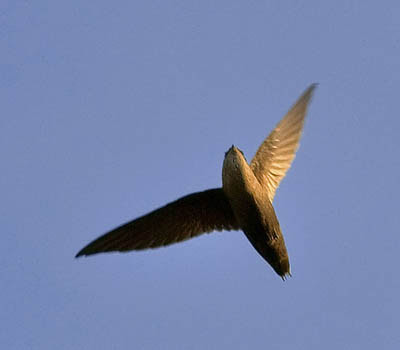 |
| Chimney Swift. Jim McCulloch CC 2.0 |
Range in Massachusetts: Chimney Swifts are summer residents throughout Massachusetts.
Identification:
Size: Small bird. Smaller than House Finches or Cliff Swallows.
Shape: Small head on short neck, very short tail. Thin pointed wings with no apparent bend at the wrist as most other birds.
Bill: Very short, wide.
Color: Gray-brown throughout.
Habitat, range & behavior: Open sky, above forests or residential areas.
They are summer residents east of the Rockies from southern Canada southward. They do not winter in the United States.
In fall migration they form large flocks of hundreds or thousands and swirl into large chimneys at dusk. Because the upper arm is so short as to barely exist, the flight of swifts is described as rapid and twinkly, not smooth and graceful as swallows.
Food and feeder preference: Insects caught on the wing. Will not visit feeders.
Common Birds in Massachusetts
To determine how common each species is I used the data from actual bird sightings from the citizen science program eBird. Birds are listed by frequency. That is, how often the species is recorded on checklists submitted to eBird (a percentage).
When choosing the birds to include in this article I leaned strongly to birds that are present throughout the year in good numbers. Thus, many of the common birds are year-round residents. This means that they live in the same location all year. They raise their young in your neighborhood. They don’t migrate. Or if the species does migrate, the ones living in your area don’t. If this is the case, some migrants may move into your area during certain times of year, adding to the same species that are in your yard full time.
Some migrant birds visit your yard during the “summer.” Often, they arrive in spring and remain until late fall. They nest and raise their young in your neighborhood. These are the summer residents.
Other migrant birds visit your backyard during the “winter.” Some of these winter visitors may arrive in July and remain into April. Others may only be found in the cold of December or January. They key here is that they nest and raise their young somewhere else. They only visit your yard in the non-breeding season.
Migration is an amazing spectacle.
There will be birds that fly through your region in spring or fall (or both). They may visit your backyard only a few days or weeks a year. They aren’t regular enough, or stay long enough, to be included in this article. But the number of briefly visiting migrant birds could double the number of species presented here. You may see them over time. Consult checklists in eBird for your county to see what is possible.
I have generally excluded common waterfowl, birds of prey, shorebirds, seabirds, and others that aren’t usually found in residential areas. But they may certainly fly over or be seen regularly if your home is on a shoreline, for instance.
Most common backyard birds in Massachusetts throughout the year
The following list is the backyard birds that, on average, are most common throughout the entire year. The list is ordered by most common based on the frequency of how often each bird is recorded on checklists submitted to eBird.
- Black-capped Chickadee (49% frequency)
- Blue Jay (47%)
- American Robin (46%)
- Northern Cardinal (43%)
- Song Sparrow (43%)
- American Crow (39%)
- Mourning Dove (39%)
- American Goldfinch (38%)
- Tufted Titmouse (35%)
- Downy Woodpecker (33%)
- White-breasted Nuthatch (29%)
- Red-winged Blackbird (28%)
- House Sparrow (28%)
- Common Grackle (27%)
- European Starling (23%)
- Gray Catbird (22%)
- Red-bellied Woodpecker (20%)
- House Finch (19%)
- Northern Flicker (18%)
- Dark-eyed Junco (17%)
- Carolina Wren (15%)
- White-throated Sparrow (15%)
- Chipping Sparrow (15%)
- Eastern Phoebe (12%)
- Northern Mockingbird (12%)
Most common backyard birds in Massachusetts in winter
- Black-capped Chickadee (48% frequency)
- Blue Jay (39%)
- Northern Cardinal (37%)
- American Crow (35%)
- Dark-eyed Junco (33%)
- Tufted Titmouse (33%)
- Downy Woodpecker (33%)
- White-breasted Nuthatch (30%)
- Mourning Dove (27%)
- Song Sparrow (27%)
- American Goldfinch (26%)
- House Sparrow (25%)
- American Robin (24%)
- European Starling (21%)
Most common backyard birds in Massachusetts in summer
- American Robin (63% frequency)
- Song Sparrow (54%)
- Gray Catbird (51%)
- Mourning Dove (50%)
- American Goldfinch (48%)
- Common Grackle (47%)
- Northern Cardinal (46%)
- Red-winged Blackbird (46%)
- Blue Jay (42%)
- Black-capped Chickadee (40%)
- American Crow (35%)
- House Sparrow (34%)
- Tufted Titmouse (30%)
- Chipping Sparrow (29%)
- Cedar Waxwing (28%)
- Downy Woodpecker (27%)
- European Starling (25%)
- Barn Swallow (25%)
- Eastern Kingbird (24%)
- Baltimore Oriole (24%)
- White-breasted Nuthatch (23%)
- Chimney Swift (21%)
- Northern Flicker (20%)
How do birds differ between seasons?
Black-capped Chickadees and Dark-eyed Juncos are more common in winter than in summer.
American Robins, Song Sparrows, Gray Catbirds, Mourning Doves, American Goldfinches, Common Grackles, Cedar Waxwings, Chipping Sparrows, Barn Swallows, Eastern Kingbirds, Baltimore Orioles, and Chimney Swifts are more common in summer than in winter.
Common Backyard Birds of Boston, Massachusetts
 |
| Rock Pigeon. Greg Gillson |
The following list uses eBird data to create a list of common backyard birds in Boston. The city of Boston is in Suffolk County. I will use data for Suffolk County to represent the birds in the Boston area.
Here are the most common backyard birds throughout the year in Boston:
- House Sparrow (56% frequency)
- American Robin (49%)
- European Starling (49%)
- Blue Jay (39%)
- Song Sparrow (35%)
- Rock Pigeon (33%) Learn about this species on eBird
- Northern Cardinal (33%)
- Common Grackle (32%)
- Mourning Dove (32%)
- Black-capped Chickadee (30%)
- Downy Woodpecker (27%)
- American Goldfinch (26%)
- Northern Mockingbird (21%)
- White-throated Sparrow (20%)
House Sparrows, European Starlings, and Rock Pigeons are more common in the Boston area than in the state as a whole. This speaks to the urban habitat of this city.
Black-capped Chickadees, American Crows and Tufted Titmice are less common in Boston than in the state as a whole.
Wrapping Up
If you feel like heading out into the wilderness areas of Massachusetts, there are many more common birds to be found. Here are my suggestions:
Forests and Woodlands:
White-breasted Nuthatches: Acrobatic birds with blue-gray backs and a white breast and belly, often seen clinging to tree trunks.
Cedar Waxwings: Silky gray birds with yellow bellies and red wing tips, known for their beautiful wax-like wing feathers.
Eastern Wood-Pewees: Small, flycatchers with a distinctive “pee-wee” call, found in open woodlands and forests.
Tufted Titmice: Gray birds with a tufted black crest and a white belly, seen foraging for insects in trees.
Yellow-billed Cuckoos: Large, brown cuckoos with a long, curved beak and a distinctive “kow-kow” call, usually heard in dense forests.
Open Fields and Meadows:
Killdeer: Small, noisy birds with a rusty back, white collar, and two black stripes on the face, frequently seen in open fields and meadows.
Eastern Meadowlarks: Yellow-breasted birds with black V-shaped markings on the chest, commonly heard singing in fields.
Red-tailed Hawks: Large, soaring hawks with a reddish tail and a sharp cry, often seen hovering over fields and meadows.
Barn Owls: Nocturnal owls with a white heart-shaped face and a silent flight, typically found in open fields and barns.
Common Grackles: Blackbirds with iridescent purple feathers and a harsh cackle, often seen in large flocks in fields and meadows.
Waterways and Marshes:
Great Blue Herons: Tall, wading birds with blue-gray feathers and a long, S-shaped neck, frequently seen standing in shallow water.
Green Herons: Smaller herons with green plumage and a distinctive croaking call, often found near marshes and ponds.
Mallards: Familiar ducks with green heads and brown bodies, common on lakes and ponds.
Canada Geese: Large, honking geese with black necks and white cheeks, frequently seen in lakes and marshes.
Osprey: Fish-eating hawks with brown bodies and white chests, often seen soaring over water and diving for fish.
Frequently Asked Questions
What is the state bird of Massachusetts?
The proud state bird of Massachusetts is the Black-capped Chickadee!
These lively and curious little birds are a familiar sight in backyards, forests, and woodlands throughout the state. They’re easily recognizable by their small size, gray back, black bib, white cheeks, and cheerful “chick-a-dee” call.
The Black-capped Chickadee was officially adopted as the state bird of Massachusetts in 1941, and for good reason. They represent resilience, intelligence, and adaptability, qualities that resonate with the state’s history and spirit. These resourceful birds can store thousands of seeds in their memories, ensuring they have food throughout the harsh winter months.
What kind of bird is gray with a white belly in Massachusetts?
Identifying a bird based solely on its grey color and white belly can be tricky as several species match that description in Massachusetts. To narrow it down, additional information like size, location, habitat, and any markings or behavioral characteristics would be helpful.
Here are some possibilities based on just the grey and white description:
Dark-eyed Junco: Common winter visitors, males are slate grey with a white belly, females are browner. Seen in open fields, forests, and backyards.
Slate-colored Junco: Less common than Dark-eyed Junco, similar appearance but with a blue-grey cast to the plumage. Found in coniferous forests.
Tree Sparrow: Gray with a streaked chest and white belly. Seen in fields, open woodlands, and brushy areas.
White-throated Sparrow: Gray back with white throat and wing bars. Found in a variety of habitats, including forests, fields, and backyards.
Where can I find a red-bellied Woodpecker in Massachusetts?
Finding a Red-bellied Woodpecker in Massachusetts is exciting! While not as historically common as it once was, these vibrant birds have gradually expanded their range throughout the state and can now be found in a variety of locations. Here are some tips to increase your chances of spotting one:
Suitable habitat:
- Open woodlands: Look for mature deciduous or mixed forests with plenty of dead and decaying trees, which provide them with food and nesting sites.
- Parks and backyards: Large wooded parks and backyards with mature trees can also attract Red-bellied Woodpeckers, especially if they offer feeders stocked with suet or sunflower seeds.
- Edge habitats: The borders between forests and fields or meadows can be attractive foraging grounds for these birds.
Look and listen:
- Appearance: Red-bellied Woodpeckers are medium-sized woodpeckers with black and white barring on their backs and wings, a bright red head and nape (males have more extensive red), and a white belly.
- Sound: Listen for their loud drumming sound, created by hammering their beak against trees to attract mates and find food. They also have a variety of calls, including a harsh “cheee-er” and a high-pitched “pee-wee.”
Specific locations:
- Western Massachusetts: Red-bellied Woodpeckers are more common in the western part of the state, where they have been established for longer. Check out areas like the Berkshires, Pioneer Valley, and Connecticut River Valley.
- Urban areas: Surprisingly, these woodpeckers are adapting well to urban environments. Look for large parks or wooded neighborhoods with mature trees.
- State parks and wildlife sanctuaries: Many state parks and wildlife sanctuaries in Massachusetts offer good opportunities to see Red-bellied Woodpeckers. Some examples include Great Brook Farm State Park, Wachusett Mountain State Park, and the Massachusetts Audubon sanctuaries.
Related Articles:
34 of the most common birds in the United States (with photos)
Feeding winter birds in Massachusetts
Red, Orange, & Yellow birds of Massachusetts
Please also check out my recommended products page. There I maintain a list of the best feeders, bird foods, binoculars, bird baths, fountains, books and other bird watching items.



